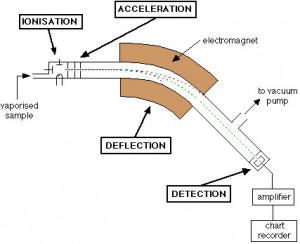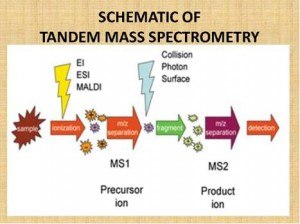The most common bioanalytical method in use today is LC/MS/MS, or liquid chromatography (LC) tandem mass spectrometry (MS). This is a very versatile, robust, and sensitive methodology that is used for nearly all small molecules. In addition, this technology is amenable to automation and unattended analysis. The LC/MS/MS methodology is very similar to HPLC/UV, which was discussed in my previous post.
LC/MS/MS utilizes liquid chromatography in a similar manner as described for HPLC. However, the “HP” was dropped because different liquid chromatography technologies can be connected to mass spectrometry detectors … and the abbreviation HPLC/MS/MS is just too long! There is one difference between the chromatography used prior to UV detection and MS detection. However, we will discuss that after we describe MS detection.

Mass Spectrometry Schematic
Mass spectrometry is a detection method that relies on the mass-to-charge ratio of a compound. Following the chromatographic separation, molecules are ionized using an energy source. These ionized molecules then pass through a set of magnets, which further separates molecules based on their mass-to-charge ratio. Detection is performed based on charged particles striking a detector and creating current. The detector only detects charges and cannot differentiate based on mass. The magnetic separation provides the selectivity of the methodology. Thus two molecules that are ionized at the same time, but have different masses can be detected independently using MS detection. Similarly, two molecules that are ionized at the same time and have different masses, but have different charges can be detected independently using MS detection.
Further specificity can be obtained when multiple ionization events occur. The second ionization process fragments the molecules into pieces that each have their own mass-to-charge ratio. These pieces are called daughter ions and can be detected. Each parent molecule fragments in a predictable fashion, thus even if two parent molecules have the same mass-to-charge ratio, if they break into different daughter ions, these can be differentiated. The multiple ionization event method is called tandem mass spectrometry (or MS/MS). The MS/MS technology is only used when a single ionization is not adequate to achieve the desired sensitivity.

Tandem Mass Spectrometry
The unique specificity of mass spectrometry detection permits more flexibility with the liquid chromatographic separations. Because molecules can be uniquely identified by MS, even if they exit chromatography together, the liquid chromatography becomes less important for LC/MS/MS than it is for HPLC/UV. Often, crude chromatographic techniques are adequate for LC/MS/MS, where complete separation is required for HPLC/UV. The results is that run times can be much shorter with LC/MS/MS, and precision and accuracy are increased. It really is the best of both worlds!
The primary challenges in MS detection is controlling the ionization process. Problems with incomplete ionization and interference can lead to poor precision and accuracy with the MS detector. These problems can be resolved with a variety of different ionization techniques, solvents, and even chromatographic separations. Additional techniques include time of flight MS, ion capture MS, and others. These special methods use different MS detector setups to improve the precision, accuracy, and sensitivity of MS detection.
It is unlikely that you will be an expert in mass spectrometry after reading this post; however, you should be able to understand the fundamental tenets of the technology and how it is used in bioanalysis.
Today, drug development is carried out in human subjects and animals. However, as computing power and the number of sophisticated technology platforms grow exponentially, and our knowledge of human health and disease increases, the virtualization of clinical research and development will grow steadily.


